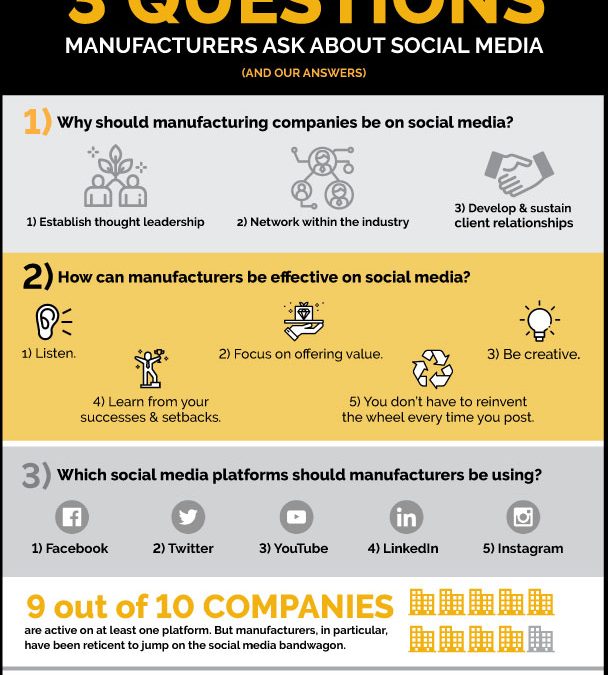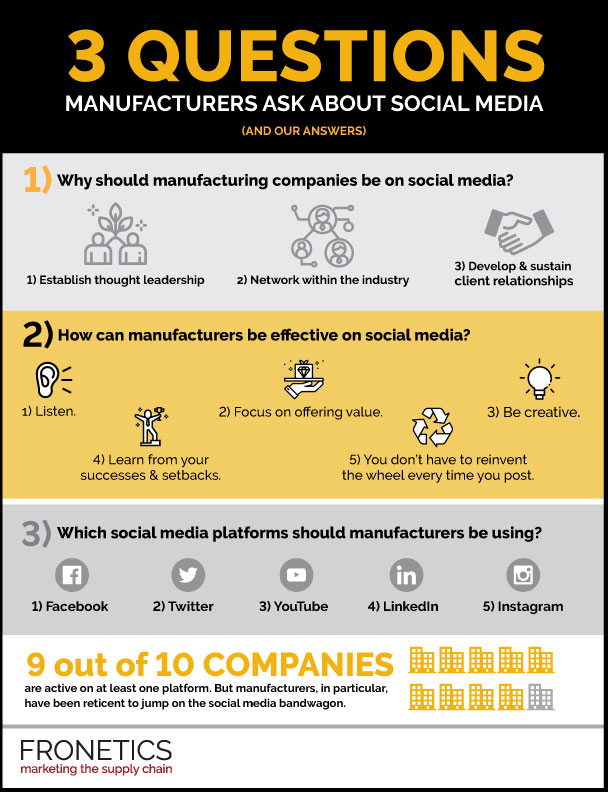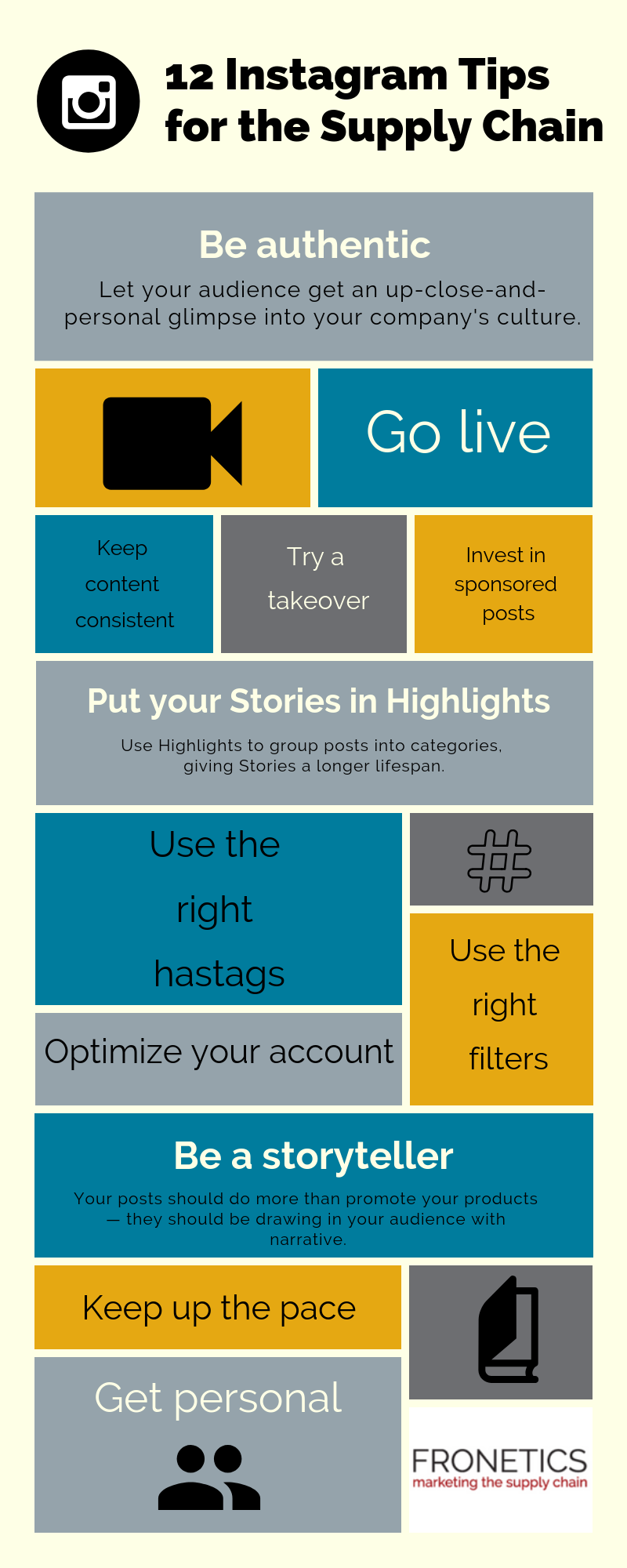
by Fronetics | May 22, 2019 | Blog, Content Marketing, Logistics, Marketing, Social Media, Supply Chain
Social listening describes the process of scanning online platforms to find the sentiment around your brand. Here are 4 ways that social listening can boost SEO.
Highlights:
- Social listening describes the process of scanning social media platforms, blogs, news websites and other digital forums to find the mention of any keywords.
- Regularly monitoring the sentiment around your brand through social listening can help prevent a problem before it blows up.
- Track your organic brand mentions and use that information to create a strategy about how to grow brand awareness.
Video transcript:
This is Elizabeth Hines. I’m the Creative Director at Fronetics, and today we’re talking about four ways social listening can boost your SEO.
Social listening describes the process of scanning social media platforms, blogs, news websites and other digital forums to find the mention of any keywords. In particular the name of your company or your CEO for example, to figure out the general sentiment around your company and your people. We used to use social listening mainly for social media marketing, but it can also be a really effective search engine optimization tool if you do it properly. So here are four ways social listening can boost your SEO.
1. Learn if your backlinks are coming from spammy websites
Backlinks from spammy or untrustworthy websites can negatively impact your search ranking. So a Google executive recently noted that this is just a normal part of being on the web and really you shouldn’t worry that much about it. But the one exception would be if there’s some kind of dedicated activity from a competitor, for example, buying up a lot of links and trying to ruin your search ranking. In this instance you should consider disavowing them and using social listening to figure that out.
2. Find guest blogging opportunities
One of the greatest benefits of social media is the opportunity to network with your industry peers and social influencers. Building relationships with reputable businesses and people could be a gateway to guest blogging, which is one of the most sound and effective ways to build your reputation with search engines, not to mention the people that follow those peer sites and influencers.
3. Monitor your brands reputation
Mistakes happen and even companies with the best intentions will sometimes suffer from a social media crisis. So regularly monitoring the sentiment around your brand through social listening can help prevent a problem before it blows up, goes viral or at least is big enough for Google’s algorithm to down rank you for providing a poor user experience.
4. Grow brand mentions
Now a lot of people will tell you to use social listening to find linkless backlinks, which are websites that mention your content but don’t provide a hyperlink to your site. Then you should reach out to those people and see if they’ll add that link in. But in my opinion, this is an enormous waste of time. We’re seeing that linkless backlinks are becoming equally as important as regular backlinks for search engine optimization. So instead, I encourage you to use that time and energy to track your organic brand mentions and use that information to create a strategy about how to grow more. For example did you say something on Reddit that got lots of attention? Well, you should do more of that.
For more tips like these, check out our blog at fronetics.com.
Related posts:


by Fronetics | May 1, 2019 | Blog, Content Marketing, Logistics, Manufacturing & Distribution, Marketing, Social Media, Supply Chain
We get many queries from manufacturers about social marketing — mostly, why and how should I use it — so here are our answers to the most-popular questions manufacturers ask about social media.
Highlights:
- Facilitate networking opportunities, thought leadership, and prospect/client relationships.
- Consider using popular platforms like YouTube and Instagram to engage users and drive website traffic.
- Don’t use social media to push your products.

(Made with Canva)
B2B operations have increasingly embraced social media as a strategic marketing tool. In fact, 9 out of 10 companies are active on at least one platform. But manufacturers, in particular, have been reticent to jump on the social media bandwagon.
If your manufacturing operation isn’t making use of social media as a tool to engage with your audience, you’re missing out on big lead generation potential. Manufacturers like the Dow Chemical Company, ArcelorMittal, and CAT Products are among those that have figured out how to harness the power of social media.
To help you launch or refine your efforts, we’ve put together the following answers to the most-popular questions manufacturers ask about social media.
Why should manufacturing companies be on social media?
There are three major reasons that manufacturing brands should be all over social media:
- Establish thought leadership
- Network within the industry
- Develop and sustain client relationships
Notice that none of these involve selling products. As with content marketing in general, good social media marketing isn’t about pushing your products.
[bctt tweet=”The value of social media for manufacturers is in its potential to establish and expand thought leadership and to cultivate meaningful and fruitful relationships within your industry and among prospects and clients.” username=”Fronetics”]
To make the most of social media as a marketing tool, abandon the idea that it’s about blatant sales pitches. Instead, approach it from the perspective that it’s an inherently social tool – that is, its value for manufacturers is in its potential to establish and expand thought leadership and to cultivate meaningful and fruitful relationships within your industry and among prospects and clients.
Which social media platforms should manufacturers be using?
Not all social media platforms are created equal. Each requires its own strategy, content format, and media. We recommend that manufacturers consider these five platforms:
1) Facebook
Facebook is an excellent place to share content with a wide segment of your audience, to promote engagement (through likes, comments, and shares), and to engage with peers and prospects. Not only that, the savviest marketers are using Facebook to understand their industry better – everything from strategies of peer brands to a fuller picture of your target buyer persona to the informational or product needs of your prospects.
2) Twitter
Twitter’s format is about brief, pithy content, used to engage with and inform your audience. This is an ideal place to let customers know what you’re planning next, to establish your corporate personality, and to let your audience in on a slice of your day-to-day operations and values.
3) YouTube
Video marketing for manufacturers is skyrocketing. With video being the most popular form of content online today, YouTube is an obvious choice for marketers. Whether it’s “how to” videos, footage of your operations, or interviews with subject-matter experts, your brand should be using YouTube to drive search traffic and educate prospects.
4) LinkedIn
B2B marketers unequivocally rank LinkedIn as the most effective network for lead generation, follower engagement, and traffic to their websites. An ideal place to engage with industry leaders, LinkedIn is also great for distributing content to a focused audience.
5) Instagram
The popularity of this highly visual platform has continued to skyrocket – it’s currently the second-most-used social media platform (up from fourth just two years ago). And believe it or not, this picture-based network is a powerhouse for B2B brands. We’ve written extensively about how brands can leverage Instagram and Instagram Stories. Suffice it to say, this is a perfect place to post your most engaging visual content and actively engage with followers.
How can manufacturers be effective on social media?
As with any content marketing effort, a well-thought-out social media strategy is a big part of success. As you create and begin to implement your strategy, start with these five tips.
1) Listen.
Before you post even a single piece of content, start by listening to your audience. In the days before social media, marketers had it much harder when it came to determining audience needs and preferences. Use these platforms to research your target prospects, as well as how competitors are engaging followers. Make note of the questions your target audience has, frustrations or challenges they express, and what types of content they engage with.
2) Focus on offering value.
You’d be surprised how many manufacturers neglect to place a premium on simply being useful with their social media content. It’s not complicated: If you post relevant, valuable content for your target audience, you’ll boost engagement, grow brand awareness, and generate and convert more leads.
3) You don’t have to reinvent the wheel every time you post.
One of the great things about social media is that it rewards not only content creation, but content curation. While you do want to be posting original content most of the time (experts recommend about 60%), a good chunk of your posting activity should include curating relevant content from third parties to share with your followers.
4) Be creative.
Separating yourself from your competitors can be a challenge, but it’s one worth striving toward. Start by asking yourself what makes your operation unique, what’s special about your process, what industry-leading expertise does your executive team have, what unusual perspective can you offer? Next, start breaking these four rules.
5) Learn from your successes and setbacks.
There are many tools out there to help you track the results of your social media efforts. Determine the right KPIs for your business and keep track of your results relentlessly. These metrics will allow you to study your impact and frequently tailor your strategy accordingly.
It’s time for manufacturers to fully embrace the marketing potential of social media. Whether you create and implement your own strategy, or decide to outsource your social media efforts, social media is a powerful set of tools that manufacturers should be harnessing.
Are there other questions manufactures ask about social media that we missed? Let me know in the comments.
Related posts:


by Fronetics | Apr 16, 2019 | Blog, Content Marketing, Marketing, SEO, Video Marketing
With the growing popularity of video, it’s harder for video posts to rank in search results. Here’s what marketers need to know about SEO and video posts.
Highlights:
- When choosing your video hosting platform, it’s important to consider the reasons why you want your videos to rank, such as lead generation or brand awareness.
- Spend time crafting an engaging video title and description and make sure to use keywords audiences are actually searching for.
- Don’t solely rely on optimizing your video to receive placement on search engines. It’s just as important that the rest of the page is optimized for SEO.
Video transcript:
I’m Ulrika Gerth, and I’m the Content Writer and Strategist at Fronetics. Today I’m going to talk about what you need to know about SEO and video posts.
So video SEO is simply optimizing your video to be indexed and rank on the search engine results pages, like Google.
In the last few years, video marketing has become more and more popular among businesses and it’s easy to see why. It’s cost effective and easy to produce. But with the explosion of video, it’s also become much harder to get ranked on universal search results.
Here are a few ways to optimize your videos.
1. Pick the best platform.
When choosing your video hosting platform, you need to consider the reasons why you want your videos to rank. Are you optimizing your video to gain traffic and generate leads? Or are you more interested in thought leadership and brand awareness?
2. Make the video engaging.
The video thumbnail is what searchers will see when your video is indexed, and therefore it plays an important role in whether they will click on your video.
3. Pay attention to the title and description of your video.
Just like they do for a blog post, the title and description play a role in ranking videos. Spend time crafting an engaging video title and description. Make sure you do keyword research so you use keywords people are actually searching for.
4. Ensure the rest of your page is relevant to the video and optimized for SEO.
You can’t rely only on optimizing your video to receive placement on search engines. It’s just as important that the rest of the page is optimized for SEO, or the search engines won’t bother to crawl it in the first place.
For more information, visit fronetics.com.
Related posts:


by Fronetics | Apr 11, 2019 | Blog, Content Marketing, Current Events, Logistics, Marketing, Social Media, Supply Chain
Content marketing is no longer optional. It’s essential in creating brand awareness, educating audiences, and building credibility. Here’s a look at the biggest digital marketing trends for 2019.
Highlights:
- The content marketing industry is expected to be worth more than $400 billion by 2021.
- Video is currently the most popular form of content being consumed online today.
- Peers and colleagues are the third most influential source of information for B2B purchasing, right behind online searches and your website.
A recent article by Forbes on content marketing notes: “As recently as a few years ago, marketers handled content mostly as a side project. It was more of a bonus than an essential role — something you did when you had time because it took a backseat to more traditional marketing projects and responsibilities. That’s changed.”
Boy, has that changed. The content marketing industry is expected to be worth more than $400 billion by 2021.
[bctt tweet=”The content marketing industry is expected to be worth more than $400 billion by 2021.” username=”Fronetics”]
The 2018 report from the Content Marketing Institute shows just how prevalent digital and content marketing is, and how essential it has become to creating brand awareness, educating your audience, and building credibility and trust with your customers.
Supply chain & logistics marketers: Trends to watch
So, where is content marketing headed in 2019? Marketing budgets are still on the rise, and supply chain and logistics companies are increasingly seeing the value in moving to an inbound marketing strategy driven by original content.
These are the six notable trends to consider when planning your 2019 content marketing strategy.
1. Video
Video is currently the most popular form of content being consumed online today, and video marketing will continue to have substantial value in 2019.
Smart supply chain marketers should start the new year by developing a visual storytelling strategy that offers consistent delivery of valuable content.
What’s your best bet? Be helpful and teach your audience something worthwhile to them.
2. Chatbots
The rise of chatbots – automated computer programs that simulate human conversation in messaging apps – is expected to continue in 2019. Business Insider recently reported that the number of people on messaging apps surpassed the number of users on social networks!
Chatbots are just one of the ways artificial intelligence will shape the content marketing landscape in 2019, but their ability to drastically increase customer engagement puts them on the short list for a major trend to watch in the coming year.
3. Voice search
Voice search is becoming an increasingly prevalent means of attaining information. Statistics vary, but it’s expected that anywhere between 30-50% of all searches will be voice searches by 2020. A recent report by NPR and Edison Research found that the rise of smart speakers is substantially changing consumer routines and purchasing behavior.
A good content marketing strategy for 2019 should consider how your customers might use voice search in your industry, and what you can do to maximize your content’s ability to respond.
4. Long-form content
I love this one, because it harkens back to humble beginnings of content marketing and the desire to put informative, quality content in front of a targeted interested audience.
Long form content – white papers, case studies, and lengthier blog posts e.g. – will have a resurgence of renewed appreciation in 2019. Why? Because many industries, including supply chain and logistics industries, are saturated with tons of mediocre short form content. People are increasingly looking to weed through it all for substantial quality posts from trusted sources. In addition, search engines will favor longer posts in results rankings.
Cheers to 2019 being the year of quality over quantity!
5. Brand ambassadors
We wrote about brand ambassadors as we headed into 2018, but they are worth mentioning again as we look forward to 2019. Brand ambassadors are employees that influence the B2B buying decisions of others, and they are an often-overlooked resource with more traditional marketing tactics.
Peers and colleagues are the third most influential source of information for business to business (B2B) purchasing, right behind online searches and your website! And there’s nothing more credible than a friend who speaks highly of their company’s product or service.
Definitely consider how you can help make brand ambassadors out of your employees in 2019.
6. Market Influencers
The final trend to watch in 2019 is influencer marketing, a form of marketing which focuses on influential people rather than the market as a whole.
Basically, marketers identify individuals who might have influence over potential buyers and create marketing campaigns and activities around these influencers. In many ways, this works similarly to a brand ambassador, where a single person influences their network of friends; in this case, however, the market influencer has a large network and a lot of “friends” who listen.
Influencer marketing will be a huge trend in marketing for 2019, and it would be worth considering who might be an influencer in your industry in the coming year and what your company might do reach them.
So, there you have it. As we head into 2019, these are the trends to watch and plan for in content marketing space.
The B2B buying climate is growing longer and more complex, and content marketing is so effective throughout the entire sales cycle if it’s done well. The end of the year is a great time to revisit your marketing strategy and make any necessary changes for the coming year.
This post originally appeared on EBN Online.
Related posts:

by Fronetics | Mar 20, 2019 | Blog, Content Marketing, Marketing, Social Media
Many B2B organizations are using Instagram to grow business. Here are a dozen Instagram tips to help you use the platform effectively.
Highlights:
- Instagram has become the second most used social media platform, up from fourth in 2017.
- Audiences love real-time content, like Instagram Stories. It lets them feel a genuine, human connection — the creation of which sometimes poses a challenge for B2B marketers.
- An effective Instagram presence has the potential to grow brand awareness, improve your reputation, and generate qualified leads.
Recent research on social media use shows that 66% of brands now use Instagram. As of 2018, it was second-most used platform by businesses, up from fourth in 2017. If you’re considering using this social media network for your business, which you should be, our 12 Instagram tips can help you get started.
12 Instagram Tips for Supply Chain Companies

(Made with Canva)
1. Be authentic
Many supply chain companies often fall into the trap of using stock photography or overly staged promotional pictures of products. The ethos of Instagram is all about authenticity and personality. Let your audience get an up-close-and-personal glimpse into your company’s culture with real photos of the people, places, and things that make your business run every day.
2. Optimize your account
Before we get to anything fancy, take a step back and make sure your Instagram account is fully optimized. This means you need:
- a bio with a link to marketing or product pages related to a specific keyword or hashtag;
- image captions, which can reference the link in your bio;
- a search-friendly username; and
- a compelling profile image that reflects your company.
3. Go live
Live video is the “it” trend in social media marketing, with 63% of marketers reporting that they plan on adding it to their overall strategy. Audiences love real-time content, and it lets them feel a genuine, human connection — the creation of which sometimes poses a challenge for B2B marketers.
4. Put your Stories in Highlights
In addition to its Stories feature, Instagram now lets users create a featured group of “Highlights” in various categories on their profiles. Stories have only a 24-hour lifespan, so featuring your most effective Stories clips in Highlights gives them a second life and a chance to engage future followers. One of the best features of Stories and Highlights is that it allows companies to view and analyze how users have viewed and interacted with their content.
5. Keep up the pace
Instagram is one of the easiest social media platforms to post on. That means you can quickly snap photos wherever you are — say, at a conference or event, or even on your way into the office — and publish it instantly. This is great for reaching the coveted millennial audience, which seems to have an unquenchable thirst for consuming content, particularly images and graphics.
6. Keep your content consistent
Posting on a consistent timetable is crucial to maintaining an active following. Posting irregularly means you risk your followers forgetting about you, and posting all at once can annoy and drive followers away. Ideally, companies should post 2-3 times a day, but you’ll need to test how many times a day is most effective for your particular business in engaging your specific audience. For more, check out our guide to when to post on social media.
7. Try a takeover
Taking over the Instagram account of a partner company or customer is a great way to draw attention from an existing and relevant audience, providing mutual benefits to both parties.
8. Invest in sponsored posts and product reviews
Optimizing your account and following Instagram best practices will go a long way toward earning authentic followers that could become future leads and/or customers. But to really boost your impact, it pays to take advantage of influencer marketing on Instagram. Create a list of large accounts in your vertical (think industry media sites and partners), follow them, and reach out to their marketing team to ask about sponsored-post pricing. Be on the lookout for influencers with a high engagement rate relative to number of followers.
[bctt tweet=”Optimizing your account and following Instagram best practices will go a long way toward earning authentic followers that could become future leads and/or customers.” username=”Fronetics”]
9. Use the right hashtags
One of the most effective ways to grow your Instagram following is to use hashtags effectively. Since Instagram gives users the ability to follow hashtags that interest them, and they function as links to other relevant content, choosing the right hashtags is the ideal way to reach and engage your target audience.
Keep an eye on accounts of peer brands to stay up to date with the best hashtags to use. The most effective hashtags are short, memorable, and easy to read. You can also use an online tool like InconoSquare or Websta to find relevant hashtags for your business.
10. Use the right filters
Sure, filters are great for turning boring or poorly lit photos into more engaging images. But, it turns out that which filter you choose really does have an impact on engagement. These lighting and color presets offered by Instagram have the potential to create mood and style in your image content. According to Iconosquare, these 10 filters are currently the most popular on Instagram:
- Normal (No Filter)
- Clarendon
- Juno
- Lark
- Ludwig
- Gingham
- Valencia
- X-Pro II
- Lo-fi
- Amaro
11. Be a storyteller
Instagram is all about visual storytelling. Your posts should do more than promote your products — they should be drawing in your audience with narrative told through a visual format. Instagram Stories are an ideal way to engage your audience!
12. Get personal
Go in deep and personal with your customers by answering their questions via 10-second videos. You let your viewers feel like they’re being heard. Plus, short videos are ideal for reposting.
The Bottom Line
Instagram is an extremely effective tool for B2B businesses. These Instagram tips for using the platform will help you create and nurture a loyal, engaged audience base. In turn, an effective Instagram presence has the potential to grow brand awareness, improve your reputation, and generate qualified leads.
Related posts:









